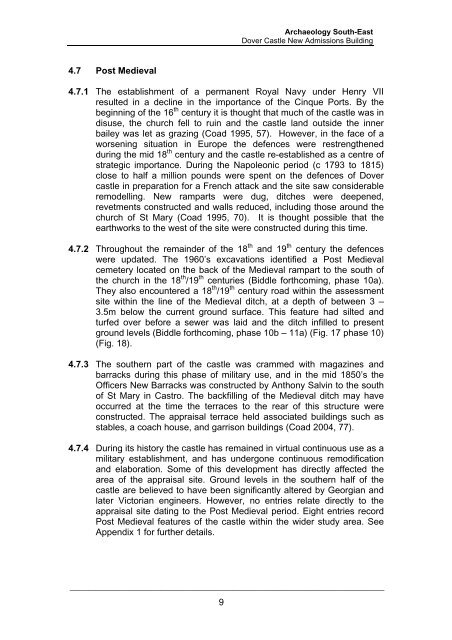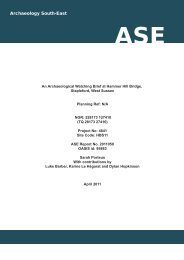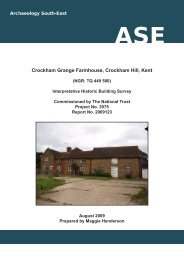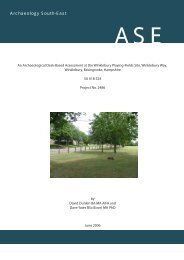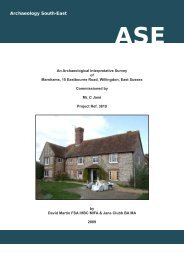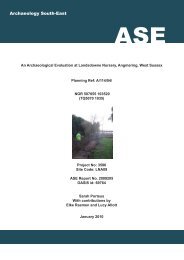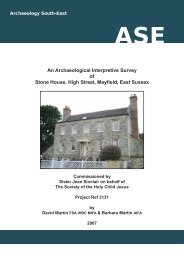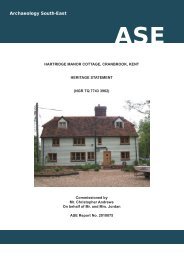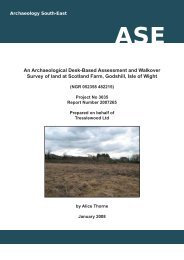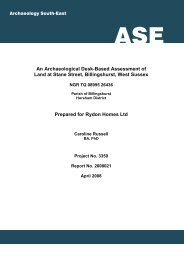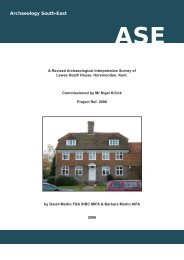ASE front cover 3127 Dover Castle - Archaeology South-East
ASE front cover 3127 Dover Castle - Archaeology South-East
ASE front cover 3127 Dover Castle - Archaeology South-East
You also want an ePaper? Increase the reach of your titles
YUMPU automatically turns print PDFs into web optimized ePapers that Google loves.
<strong>Archaeology</strong> <strong>South</strong>-<strong>East</strong><strong>Dover</strong> <strong>Castle</strong> New Admissions Building4.7 Post Medieval4.7.1 The establishment of a permanent Royal Navy under Henry VIIresulted in a decline in the importance of the Cinque Ports. By thebeginning of the 16 th century it is thought that much of the castle was indisuse, the church fell to ruin and the castle land outside the innerbailey was let as grazing (Coad 1995, 57). However, in the face of aworsening situation in Europe the defences were restrengthenedduring the mid 18 th century and the castle re-established as a centre ofstrategic importance. During the Napoleonic period (c 1793 to 1815)close to half a million pounds were spent on the defences of <strong>Dover</strong>castle in preparation for a French attack and the site saw considerableremodelling. New ramparts were dug, ditches were deepened,revetments constructed and walls reduced, including those around thechurch of St Mary (Coad 1995, 70). It is thought possible that theearthworks to the west of the site were constructed during this time.4.7.2 Throughout the remainder of the 18 th and 19 th century the defenceswere updated. The 1960’s excavations identified a Post Medievalcemetery located on the back of the Medieval rampart to the south ofthe church in the 18 th /19 th centuries (Biddle forthcoming, phase 10a).They also encountered a 18 th /19 th century road within the assessmentsite within the line of the Medieval ditch, at a depth of between 3 –3.5m below the current ground surface. This feature had silted andturfed over before a sewer was laid and the ditch infilled to presentground levels (Biddle forthcoming, phase 10b – 11a) (Fig. 17 phase 10)(Fig. 18).4.7.3 The southern part of the castle was crammed with magazines andbarracks during this phase of military use, and in the mid 1850’s theOfficers New Barracks was constructed by Anthony Salvin to the southof St Mary in Castro. The backfilling of the Medieval ditch may haveoccurred at the time the terraces to the rear of this structure wereconstructed. The appraisal terrace held associated buildings such asstables, a coach house, and garrison buildings (Coad 2004, 77).4.7.4 During its history the castle has remained in virtual continuous use as amilitary establishment, and has undergone continuous remodificationand elaboration. Some of this development has directly affected thearea of the appraisal site. Ground levels in the southern half of thecastle are believed to have been significantly altered by Georgian andlater Victorian engineers. However, no entries relate directly to theappraisal site dating to the Post Medieval period. Eight entries recordPost Medieval features of the castle within the wider study area. SeeAppendix 1 for further details._____________________________________________________________________9


